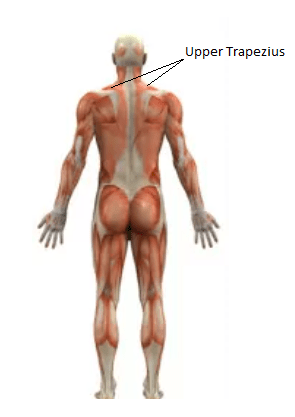Upper Trapezius Anatomy
Updated:
Understanding the anatomy of the upper trapezius muscle is crucial for healthcare professionals, athletes, and individuals interested in maintaining optimal shoulder girdle health. This comprehensive article explores the various aspects of upper trapezius anatomy, including its origin, insertion, action, function, nerve supply, blood supply, palpation techniques, clinical relevance and common injuries. Gain valuable insights into the significance of upper trapezius anatomy and its role in musculoskeletal well-being.

Origin
The upper trapezius muscle originates from the external occipital protuberance (base of the skull), the medial part of the superior nuchal line (a bony line located at the base of the skull), and the nuchal ligament. It extends laterally along the superior nuchal line, covering the spinous processes of the cervical and upper thoracic vertebrae.
Insertion
Converging fibers of the upper trapezius muscle insert onto the lateral third of the clavicle, the acromion process, and the spine of the scapula. This broad attachment enables a wide range of movements in the shoulder girdle.
Action and Function
The primary function of the upper trapezius muscle involves the elevation and upward rotation of the scapula, as well as the extension and lateral flexion of the neck. It also plays a crucial role in stabilizing the scapula during movements such as reaching overhead and performing pulling motions.
Nerve Supply
The upper trapezius muscle receives its innervation from the accessory nerve (cranial nerve XI) and the ventral rami of the third and fourth cervical nerves. The accessory nerve controls the muscle’s contraction and overall function.
Blood Supply
The upper trapezius muscle is primarily supplied with blood by the transverse cervical artery, a branch of the thyrocervical trunk. Additionally, branches of the occipital artery and the superficial cervical artery contribute to its vascularization.
Palpation of Upper Trapezius Anatomy
Palpation techniques can be employed to assess the upper trapezius muscle for tenderness, tension, or trigger points. These techniques involve gentle pressing or kneading to identify areas of discomfort or dysfunction, aiding in the diagnosis and treatment of related conditions.
Clinical Relevance
The upper trapezius muscle is commonly associated with musculoskeletal disorders such as trapezius myalgia, tension headaches, and neck pain. A thorough understanding of its anatomy is crucial for accurate diagnosis and targeted treatment, including exercises, manual therapy, and postural corrections.
Upper Trapezius Anatomy – Common Injuries
Injuries affecting the upper trapezius muscle can include strains, trigger points, and myofascial pain syndrome. These injuries may result from overuse, poor posture, repetitive movements, or trauma. Treatment options often include rest, ice, stretching, strengthening exercises, manual therapy, dry needling and other rehabilitative techniques.
Conclusion
By delving into the various aspects of upper trapezius anatomy, we gain a comprehensive understanding of its role in shoulder girdle function and musculoskeletal health. This knowledge empowers healthcare professionals and individuals to effectively address related issues and promote overall well-being.
Upper Trapezius Anatomy – References:
- Trapezius Muscle by KenHub – Trapezius muscle: Anatomy, origins, insertions, actions | Kenhub
- Neumann DA. Kinesiology of the Musculoskeletal System: Foundations for Rehabilitation. 3rd ed. St. Louis, MO: Mosby Elsevier; 2016.
- Tortora GJ, Derrickson BH. Principles of Anatomy and Physiology. 15th ed. Hoboken, NJ: John Wiley & Sons; 2018.
- Drake RL, Vogl AW, Mitchell AW. Gray’s Anatomy for Students. 4th ed. Philadelphia, PA: Elsevier; 2019.
- Standring S, editor. Gray’s Anatomy: The Anatomical Basis of Clinical Practice. 41st ed. London, UK: Elsevier; 2016.
- Kendall FP, McCreary EK, Provance PG, Rodgers MM, Romani WA. Muscles: Testing and Function with Posture and Pain. 5th ed. Baltimore, MD: Lippincott Williams & Wilkins; 2005.
- Chaitow L, DeLany J. Clinical Application of Neuromuscular Techniques, Volume 1: The Upper Body. 2nd ed. St. Louis, MO: Elsevier Churchill Livingstone; 2011.
- Hammer WI. Functional Soft-Tissue Examination and Treatment by Manual Methods. 3rd ed. Sudbury, MA: Jones & Bartlett Learning; 2007.
- Maigne JY, Maigne R. Trigger Point Dry Needling: An Evidence and Clinical-Based Approach. 2nd ed. London, UK: Handspring Publishing; 2020.
- Cleland JA, Koppenhaver S. Netter’s Orthopaedic Clinical Examination: An Evidence-Based Approach. 3rd ed. Philadelphia, PA: Elsevier; 2020.
- Frank C, Lardner R. Biomechanics of the Upper Limbs: Mechanics, Modeling, and Musculoskeletal Injuries. 2nd ed. Boca Raton, FL: CRC Press; 2011.

Link to this Page
If you would like to link to this article on your website, simply copy the code below and add it to your page:
<a href="https://physioadvisor.com.au/upper-trapezius-anatomy”>Upper Trapezius Anatomy – PhysioAdvisor.com</a><br/>Learn about upper trapezius anatomy including origin, insertion, action, nerve & blood supply, function, injuries, clinical relevance & more
Return to the top of Upper Trapezius Anatomy.
